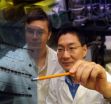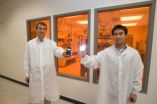(Press-News.org) AUGUSTA, Ga. – The most toxic free radical appears responsible for much of the lung damage that can result from oxygen therapy in the critically ill or injured, Medical College of Georgia researchers report.
Within just a few days, ventilators and oxygen chambers used to significantly increase oxygen levels can also dramatically increase levels of peroxynitrite, an oxidant powerful enough to break down DNA and cause proteins to malfunction, said Dr. Yunchao Su, pharmacologist in the MCG Schools of Medicine and Graduate Studies.
Oxygen toxicity is the most severe side effect of oxygen therapy in newborns and adults. The lungs take the brunt of the damage, which can include inflammation, hemorrhaging and swelling that may result in death or chronic lung problems, said Su, corresponding author of the study published in the Journal of Biological Chemistry.
"We knew it was bad but we did not know why," Su said. The good news is they may also have a solution.
Researchers found that within five days, mice placed in small oxygen chambers that mimic oxygen levels given in intensive care have dramatically elevated levels of peroxynitrite in their lungs. Free radicals, such as peroxynitrite, result from oxygen use and are safe at low levels. While it's a given that oxygen therapy produces free radicals, the significant increase in peroxynitrite was not known.
The trouble begins when high oxygen levels prompt endothelial cells that line blood vessels and tiny airs sacs in the lung to make more nitric oxide, the precursor of peroxynitrite. At high levels, nitric oxide, most often a helpful compound, combines with other free radicals produced by excess oxygen use to form the powerful peroxynitrite. "As oxygen levels increase, nitric oxide levels increase and so peroxynitrite levels do as well," Su said.
But he appears to have identified a break point in the destructive cycle. Su found that in the face of high oxygen levels, the enzyme that makes nitric oxide binds with the protein actin to produce more nitric oxide. So he developed a compound, peptide 326, that interferes with their binding and the excess peroxynitrite levels that typically follow. Su used the binding site itself as a cue for the peptide design after trying many existing compounds, including smoke, to break the bond.
Su's long term goal is for peptide 326, or something similar, to be used in patients likely after the first few days of oxygen therapy. Much as health care providers monitor blood oxygen long term to ensure sufficient levels, they could also monitor peroxynitrite levels. "It's only after several days of steady increases that the level becomes destructive," Su noted.
MCG scientists are already using peptide 326 in mice receiving oxygen therapy.
INFORMATION:
The research was funded by the National Institutes of Health, the American Heart Association and the Flight Attendants Medical Research Institute.
Dr. Dmitry Kondrikov, assistant research scientist at MCG, is first author of the paper; graduate student Shawn Elms and vascular biologist Dr. David Fulton are co-authors.
Powerful free radical causes lung damage from oxygen therapy
2010-10-06
ELSE PRESS RELEASES FROM THIS DATE:
Is your job making you fat?
2010-10-06
Montreal, October 05, 2010 – Working nine-to-five may be the way to make a living, but it may be padding more than the wallet. According to a new study from the Université de Montréal, office-workers have become less active over the last three decades and this decreased activity may partly explain the rise in obesity. Their findings, published in the early online edition of Preventive Medicine, may have health implications for the millions of people toiling behind their desks.
"People eat better and exercise more today than they did in the 1970's, yet obesity rates ...
Breakthrough e-display means electronics with high speed, high readability and low power usage
2010-10-06
Today's Oct. 4 issue of the high-impact journal, Applied Physics Letters, contains a new electrofluidics design from the University of Cincinnati and start-up company Gamma Dynamics that promises to dramatically reshape the image capabilities of electronic devices.
This patent-pending electrofluidics breakthrough by the Novel Devices Laboratory at the University of Cincinnati and partner companies Gamma Dynamics, Dupont and Sun Chemical follows about seven years of work. According to lead researcher Jason Heikenfeld, UC associate professor of electrical and computer engineering ...
Fish oil linked to increased risk of colon cancer in mice
2010-10-06
EAST LANSING, Mich. — Fish oil – long encouraged by doctors as a supplement to support heart and joint health, among other benefits – induced severe colitis and colon cancer in mice in research led by Michigan State University and published this month in the journal Cancer Research.
Jenifer Fenton, a food science and human nutrition researcher at MSU, led the research that supports establishing a dose limit for docosahexaenoic acid (DHA), one of the omega-3 fatty acids present in fish oil, particularly in people suffering from chronic conditions such as inflammatory bowel ...
'Paradigm shift' in how physicians treat peripheral artery disease
2010-10-06
A balloon angioplasty device that sucks up dangerous plaque debris could trigger a "paradigm shift" in how physicians treat peripheral artery disease, researchers write in the current issue of Endovascular Today.
"We will see a shift in how we treat lesions," write Dr. Robert Dieter of Loyola University Health System and Dr. Aravinda Nanjundappa of West Virginia University.
In two clinical trials totaling 123 patients, the device had a success rate of 97 percent to 99 percent and consistently outperformed filter devices typically used to capture debris particles, Dieter ...
Shortfalls in carotenoid intake may impact women's health
2010-10-06
GRAND RAPIDS, MICH., Oct. 5, 2010 – Only about a third of American women are meeting their fruit and vegetable intake recommendations, which means they are likely missing out on potentially important breast and ovarian health benefits (1). Along with vitamins, minerals and fiber, fruits and vegetables contain a type of phytonutrient called carotenoids, which research suggests help support women's health including breast and ovarian health.
Based on a new report called America's Phytonutrient Report: Women's Health by Color, older women have total carotenoid intakes ...
ORNL uses new technologies to take steam out of wasted energy
2010-10-06
OAK RIDGE, Tenn., Oct. 5, 2010 -- By installing wireless sensors and replacing faulty traps along the 12 miles of steam lines at Oak Ridge National Laboratory, officials expect to save as much as $675,000 per year.
With 1,600 steam traps, which normally open slightly to discharge condensed steam with a negligible loss of live steam, the problem occurs when a trap fails and that failure goes undetected and unrepaired, said Teja Kuruganti, a member of the Computational Sciences and Engineering Division.
Manual inspections of each trap is a daunting and sometimes dangerous ...
SMU geothermal mapping project reveals large, green energy source in coal country
2010-10-06
DALLAS (SMU) – New research produced by Southern Methodist University's Geothermal Laboratory, funded by a grant from Google.org, suggests that the temperature of the Earth beneath the state of West Virginia is significantly higher than previously estimated and capable of supporting commercial baseload geothermal energy production.
Geothermal energy is the use of the Earth's heat to produce heat and electricity. "Geothermal is an extremely reliable form of energy, and it generates power 24/7, which makes it a baseload source like coal or nuclear," said David Blackwell, ...
Sediment pollution should be included in water quality assessment
2010-10-06
Under the Water Framework Directive (WFD) (Directive 2000/60/CE), member states are required to achieve Good Water Status for water (continental, estuarine, subterranean and coastal water bodies) in Europe by 2015. Surface water quality is assessed taking into account the ecological and chemical status.
The quality of aquatic systems is more accurately assessed using the status of both the water column and the underlying sediment. A recent study by researchers of AZTI-Tecnalia concluded that water bodies risk being misclassified if, on evaluating their chemical status, ...
New graphene fabrication method uses silicon carbide templates to create desired growth
2010-10-06
Researchers at the Georgia Institute of Technology have developed a new "templated growth" technique for fabricating nanometer-scale graphene devices. The method addresses what had been a significant obstacle to the use of this promising material in future generations of high-performance electronic devices.
The technique involves etching patterns into the silicon carbide surfaces on which epitaxial graphene is grown. The patterns serve as templates directing the growth of graphene structures, allowing the formation of nanoribbons of specific widths without the use of ...
New findings about wind farms could lead to expanding their use
2010-10-06
CHAMPAIGN, Ill. — Wind power is likely to play a large role in the future of sustainable, clean energy, but wide-scale adoption has remained elusive. Now, researchers have found wind farms' effects on local temperatures and proposed strategies for mediating those effects, increasing the potential to expand wind farms to a utility-scale energy resource.
Led by University of Illinois professor of atmospheric sciences Somnath Baidya Roy, the research team will publish its findings in the Proceedings of the National Academy of Sciences. The paper will appear in the journal's ...


